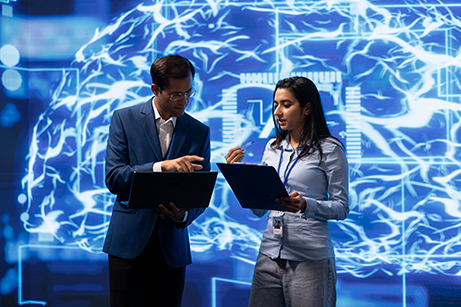AIMC Topic: Head Movements
Clear Filters Showing 11 to 20 of 38 articles
Gaze Point Tracking Based on a Robotic Body-Head-Eye Coordination Method.
Sensors (Basel, Switzerland)
Jul 11, 2023
When the magnitude of a gaze is too large, human beings change the orientation of their head or body to assist their eyes in tracking targets because saccade alone is insufficient to keep a target at the center region of the retina. To make a robot g...
A Driver Gaze Estimation Method Based on Deep Learning.
Sensors (Basel, Switzerland)
May 23, 2022
Car crashes are among the top ten leading causes of death; they could mainly be attributed to distracted drivers. An advanced driver-assistance technique (ADAT) is a procedure that can notify the driver about a dangerous scenario, reduce traffic cras...
Viewport-Based CNN: A Multi-Task Approach for Assessing 360° Video Quality.
IEEE transactions on pattern analysis and machine intelligence
Mar 4, 2022
For 360° video, the existing visual quality assessment (VQA) approaches are designed based on either the whole frames or the cropped patches, ignoring the fact that subjects can only access viewports. When watching 360° video, subjects select viewpor...
Effect of head motion-induced artefacts on the reliability of deep learning-based whole-brain segmentation.
Scientific reports
Jan 31, 2022
Due to their robustness and speed, recently developed deep learning-based methods have the potential to provide a faster and hence more scalable alternative to more conventional neuroimaging analysis pipelines in terms of whole-brain segmentation bas...
Prediction of Head Movement in 360-Degree Videos Using Attention Model.
Sensors (Basel, Switzerland)
May 25, 2021
In this paper, we propose a prediction algorithm, the combination of Long Short-Term Memory (LSTM) and attention model, based on machine learning models to predict the vision coordinates when watching 360-degree videos in a Virtual Reality (VR) or Au...
DeepLabStream enables closed-loop behavioral experiments using deep learning-based markerless, real-time posture detection.
Communications biology
Jan 29, 2021
In general, animal behavior can be described as the neuronal-driven sequence of reoccurring postures through time. Most of the available current technologies focus on offline pose estimation with high spatiotemporal resolution. However, to correlate ...
Saliency Prediction on Omnidirectional Image With Generative Adversarial Imitation Learning.
IEEE transactions on image processing : a publication of the IEEE Signal Processing Society
Jan 21, 2021
When watching omnidirectional images (ODIs), subjects can access different viewports by moving their heads. Therefore, it is necessary to predict subjects' head fixations on ODIs. Inspired by generative adversarial imitation learning (GAIL), this pap...
Controlling a robotic arm for functional tasks using a wireless head-joystick: A case study of a child with congenital absence of upper and lower limbs.
PloS one
Aug 5, 2020
Children with movement impairments needing assistive devices for activities of daily living often require novel methods for controlling these devices. Body-machine interfaces, which rely on body movements, are particularly well-suited for children as...
Automated detection of the head-twitch response using wavelet scalograms and a deep convolutional neural network.
Scientific reports
May 20, 2020
Hallucinogens induce the head-twitch response (HTR), a rapid reciprocal head movement, in mice. Although head twitches are usually identified by direct observation, they can also be assessed using a head-mounted magnet and a magnetometer. Procedures ...
EEG Signal and Feature Interaction Modeling-Based Eye Behavior Prediction Research.
Computational and mathematical methods in medicine
May 16, 2020
In recent years, with the development of brain science and biomedical engineering, as well as the rapid development of electroencephalogram (EEG) signal analysis methods, using EEG signals to monitor human health has become a very popular research fi...
Popular Topics
- Machine Learning 31964
- Neural Networks, Computer 30201
- Algorithms 27375
- Deep Learning 26880
- Artificial Intelligence 24817
- Robotics 13382
- Image Processing, Computer-Assisted 9730
- Retrospective Studies 9328
- Magnetic Resonance Imaging 6341
- Reproducibility of Results 5670
- Tomography, X-Ray Computed 4863
- Support Vector Machine 4762
- Computational Biology 4328
- Brain 4125
- Computer Simulation 3932
Recent Journals
- Scientific reports 6689
- Sensors (Basel, Switzerland) 4794
- PloS one 4186
- Neural networks : the official journal of the International Neural Network Society 3026
- Computational intelligence and neuroscience 1931
- Computers in biology and medicine 1915
- Annual International Conference of the IEEE Engineering in Medicine and Biology Society. IEEE Engineering in Medicine and Biology Society. Annual International Conference 1686
- Studies in health technology and informatics 1378
- IEEE journal of biomedical and health informatics 1167
- Journal of chemical information and modeling 1059
- Nature communications 1029
- Computer methods and programs in biomedicine 883
- Bioinformatics (Oxford, England) 872
- Journal of medical Internet research 853
- Briefings in bioinformatics 853
